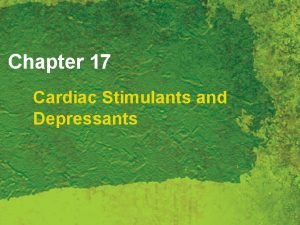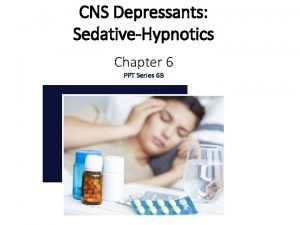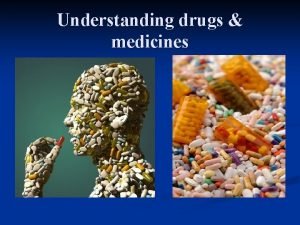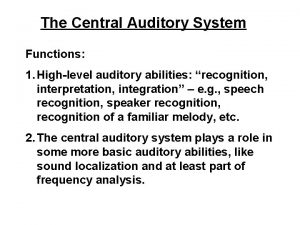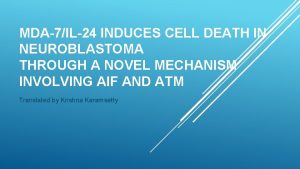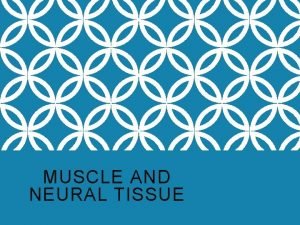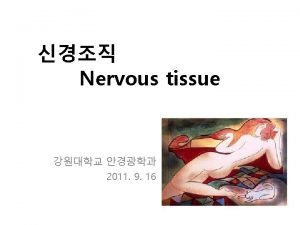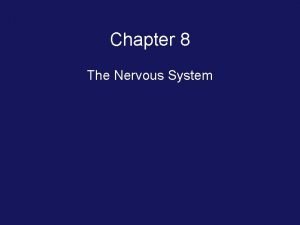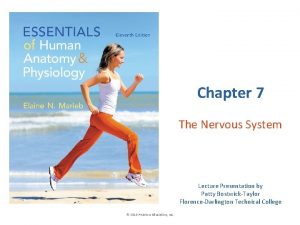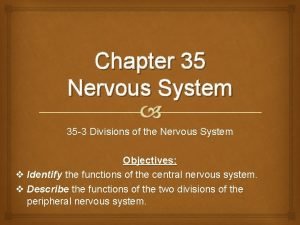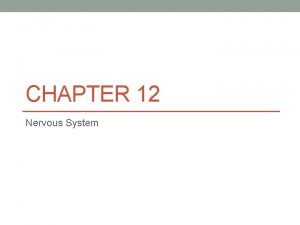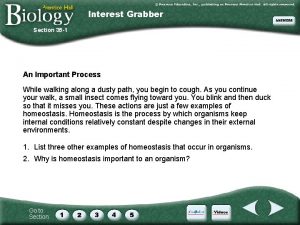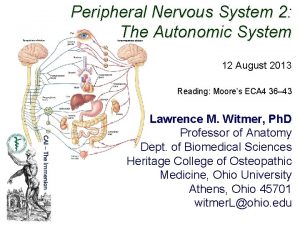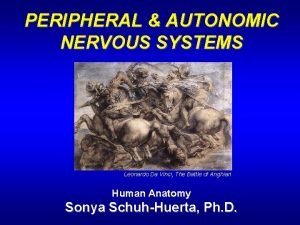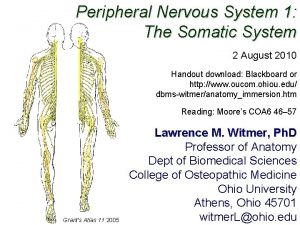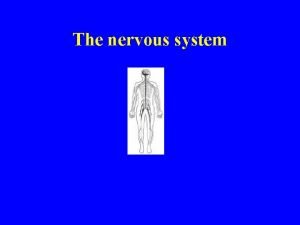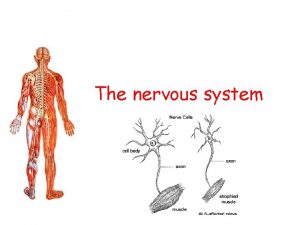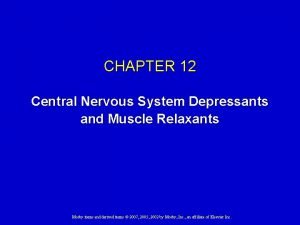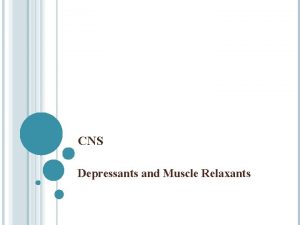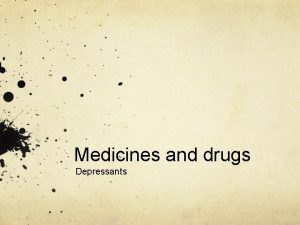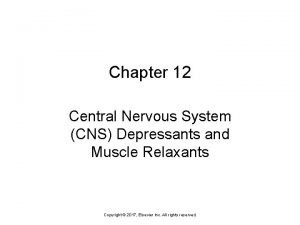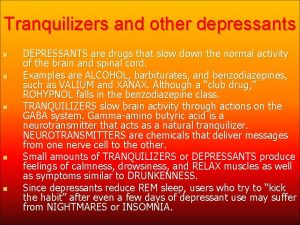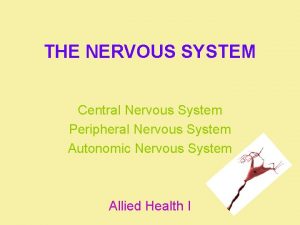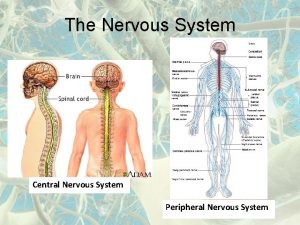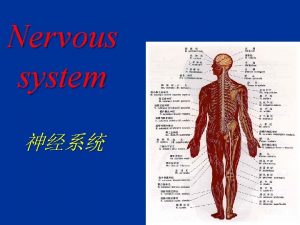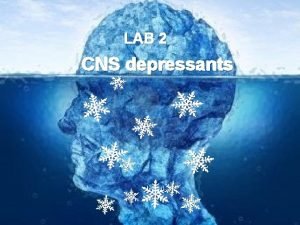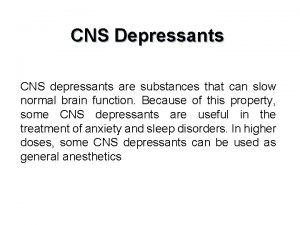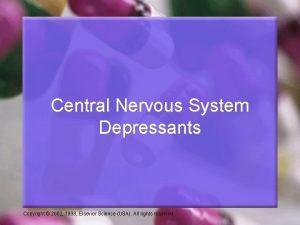Chapter 12 Central Nervous System Depressants and Muscle












































- Slides: 44

Chapter 12 Central Nervous System Depressants and Muscle Relaxants Copyright © 2014 by Mosby, an imprint of Elsevier Inc.

CNS Depressants Sedatives Drugs that have an inhibitory effect on the CNS to the degree that they reduce: Nervousness Ø Excitability Ø Irritability Ø Copyright © 2014 by Mosby, an imprint of Elsevier Inc. 2

CNS Depressants (cont’d) Hypnotics Cause sleep Much more potent effect on CNS than sedatives A sedative can become a hypnotic if it is given in large enough doses Copyright © 2014 by Mosby, an imprint of Elsevier Inc. 3

CNS Depressants (cont’d) Sedative-hypnotics—dose dependent At low doses, calm the CNS without inducing sleep At high doses, calm the CNS to the point of causing sleep Classified into three main groups: Barbiturates Ø Benzodiazepines Ø Miscellaneous drugs Ø Copyright © 2014 by Mosby, an imprint of Elsevier Inc. 4

Sleep Normal sleep is cyclic and repetitive A sleeping person is unaware of sensory stimuli within the immediate environment Sleep architecture Rapid eye movement (REM) sleep Ø Non-REM sleep Ø REM interference REM rebound Copyright © 2014 by Mosby, an imprint of Elsevier Inc. 5

CNS Depressants: Benzodiazepines Formerly the most commonly prescribed sedative-hypnotic drugs Nonbenzodiazepines currently more frequently prescribed Favorable drug effect profiles, efficacy, and safety Copyright © 2014 by Mosby, an imprint of Elsevier Inc. 6

Benzodiazepines Classified as either: Sedative-hypnotic Ø Anxiolytic (medication that relieves anxiety) Ø Copyright © 2014 by Mosby, an imprint of Elsevier Inc. 7

Benzodiazepines: Sedative-Hypnotic Types Long-acting Ø Intermediate-acting Ø diazepam (Valium), clonazepam (Klonopin) alprazolam (Xanax), lorazepam (Ativan), temazepam (Restoril) Short-acting Ø midazolam (Versed), triazolam (Halcion) Copyright © 2014 by Mosby, an imprint of Elsevier Inc. 8

Benzodiazepines: Mechanism of Action Depress CNS activity Affect hypothalamic, and limbic systems of the brain Benzodiazepine receptors Ø Gamma-aminobutyric acid (GABA) Do not suppress rapid eye movement (REM) sleep as much as barbiturates do Do not increase metabolism of other drugs Copyright © 2014 by Mosby, an imprint of Elsevier Inc. 9

Benzodiazepines: Drug Effects Calming effect on the CNS Useful in controlling agitation and anxiety Reduce excessive sensory stimulation, inducing sleep Induce skeletal muscle relaxation Copyright © 2014 by Mosby, an imprint of Elsevier Inc. 10

Benzodiazepines: Indications Sedation Sleep induction Skeletal muscle relaxation Anxiety relief Anxiety-related depression Copyright © 2014 by Mosby, an imprint of Elsevier Inc. 11

Benzodiazepines: Indications (cont’d) Treatment of acute seizure disorders Treatment of alcohol withdrawal Agitation relief Balanced anesthesia Moderate/conscious sedation Copyright © 2014 by Mosby, an imprint of Elsevier Inc. 12

Benzodiazepines: Adverse Effects Mild and infrequent Headache Drowsiness Dizziness Cognitive impairment Vertigo Lethargy Fall hazard for elderly persons “Hangover” effect/daytime sleepiness Copyright © 2014 by Mosby, an imprint of Elsevier Inc. 13

Classroom Response Question When providing education to the patient on the use of a benzodiazepine medication, the nurse will include which information? A. These medications have little effect on the normal sleep cycle. B. Using this medication may cause drowsiness the next day. C. It is safe to drive while taking this medication. D. These drugs are safe to use with alcohol. Copyright © 2014 by Mosby, an imprint of Elsevier Inc. 14

Benzodiazepines: Toxicity and Overdose Somnolence Confusion Coma Diminished reflexes Do not cause hypotension and respiratory depression unless taken with other CNS depressants Treatment symptomatic and supportive Ø Flumazenil as an antidote Copyright © 2014 by Mosby, an imprint of Elsevier Inc. 15

Benzodiazepines: Interactions Azole antifungals, verapamil, diltiazem, protease inhibitors, macrolide antibiotics, grapefruit juice CNS depressants (alcohol, opioids) olanzapine rifampin Copyright © 2014 by Mosby, an imprint of Elsevier Inc. 16

CNS Depressants: Nonbenzodiazepine Hypnotics Share many characteristics of benzodiazepines Used to treat insomnia Examples: zaleplon (Sonata), zolpidem (Ambien), eszoplicone (Lunesta), and ramelteon (Rozerem) Eszoplicone and extended-release zolpidem (Ambien CR) approved for long-term therapy Copyright © 2014 by Mosby, an imprint of Elsevier Inc. 17

CNS Depressants: Nonbenzodiazepine Hypnotics (cont’d) Ramelteon (Rozerem) Does not cause CNS depression Ø No potential for abuse Ø No withdrawal signs and symptoms Ø Copyright © 2014 by Mosby, an imprint of Elsevier Inc. 18

Herbal Products: Kava Used to relieve anxiety, stress, and restlessness and to promote sleep May cause temporary yellow skin discoloration (extended, continued intake) and visual disturbances Potential interactions with alcohol, barbiturates, and psychoactive drugs Contraindicated in liver disease, alcoholism, other conditions Patient should not operate heavy machinery during use Copyright © 2014 by Mosby, an imprint of Elsevier Inc. 19

Herbal Products: Valerian Used to relieve anxiety, restlessness, and sleep disorders May cause CNS depression, hepatotoxicity, nausea, vomiting, anorexia, restlessness, insomnia Many interactions, including with CNS depressants, MAOIs, phenytoin, warfarin, alcohol Contraindicated in cardiac and liver disease Patient should not operate heavy machinery during use Copyright © 2014 by Mosby, an imprint of Elsevier Inc. 20

Barbiturates First introduced in 1903; were the standard drugs for insomnia and sedation Habit forming; low therapeutic index Only a handful commonly used today due in part to the safety and efficacy of benzodiazepines Copyright © 2014 by Mosby, an imprint of Elsevier Inc. 21

Barbiturates: Mechanism of Action Site of action Ø Brainstem (reticular formation) By potentiating the action of GABA, nerve impulses traveling in the cerebral cortex are inhibited Copyright © 2014 by Mosby, an imprint of Elsevier Inc. 22

Barbiturates: Drug Effects Low doses: sedative effects High doses: hypnotic effects (also lower respiratory rate) Notorious enzyme inducers Stimulate liver enzymes that cause metabolism or breakdown of many drugs Ø Result in shortened duration of action Ø Copyright © 2014 by Mosby, an imprint of Elsevier Inc. 23

Barbiturates: Indications Sedatives Anticonvulsants Anesthesia for surgical procedures Copyright © 2014 by Mosby, an imprint of Elsevier Inc. 24

Barbiturates: Four Categories Ultrashort-acting Ø Sedation and control of convulsive conditions Intermediate-acting Ø Anesthesia for short surgical procedures, other uses Sedation and control of convulsive conditions Long-acting Ø Sleep induction, epileptic seizure prophylaxis Copyright © 2014 by Mosby, an imprint of Elsevier Inc. 25

Barbiturates: Adverse Effects Body System Adverse Effects Cardiovascular Vasodilation, hypotension CNS Drowsiness, lethargy, vertigo Respiratory depression, cough Copyright © 2014 by Mosby, an imprint of Elsevier Inc. 26

Barbiturates: Adverse Effects (cont’d) Body System GI Adverse Effects Nausea, vomiting, diarrhea, constipation Hematologic Agranulocytosis, thrombocytopenia Other Hypersensitivity reactions, Stevens-Johnson syndrome Copyright © 2014 by Mosby, an imprint of Elsevier Inc. 27

Barbiturates: Adverse Effects (cont’d) Reduced REM sleep, resulting in: Agitation Ø Inability to deal with normal stress Ø Copyright © 2014 by Mosby, an imprint of Elsevier Inc. 28

Classroom Response Question An elderly patient taking multiple medications has a barbiturate added to his medication regimen. When administering a barbiturate to an elderly patient, the nurse should expect A. a decrease in dosages of the other medications. B. the patient will experience increased amounts of REM sleep. C. to administer half of the usual dose of the barbiturate. D. total relief of anxiety. Copyright © 2014 by Mosby, an imprint of Elsevier Inc. 29

Barbiturates: Toxicity and Overdose frequently leads to respiratory depression and subsequent respiratory arrest Overdose produces CNS depression (sleep to coma and death) Can be therapeutic Anesthesia induction Ø Uncontrollable seizures: “phenobarbital coma” Ø Copyright © 2014 by Mosby, an imprint of Elsevier Inc. 30

Barbiturates: Toxicity and Overdose (cont’d) Treatment of overdose Symptomatic and supportive Ø Maintain adequate airway Ø Assisted ventilation/oxygen therapy Ø Fluids Ø Pressor support Ø Activated charcoal Ø Copyright © 2014 by Mosby, an imprint of Elsevier Inc. 31

Barbiturates: Drug Interactions Additive effects Ø Inhibited metabolism Ø Alcohol, antihistamines, benzodiazepines, opioids, tranquilizers MAOIs will prolong effects of barbiturates Increased metabolism Ø Reduces anticoagulant response, leading to possible clot formation Copyright © 2014 by Mosby, an imprint of Elsevier Inc. 32

Common Barbiturates pentobarbital (Nembutol) phenobarbital Copyright © 2014 by Mosby, an imprint of Elsevier Inc. 33

Classroom Response Question Barbiturates have a low therapeutic index. This means A. B. C. D. low doses are not therapeutic. the toxic range is narrow. they are habit forming. the effective, safe dosage range is narrow. Copyright © 2014 by Mosby, an imprint of Elsevier Inc. 34

Muscle Relaxants Act to relieve pain associated with skeletal muscle spasms Majority are centrally acting CNS is the site of action Ø Similar in structure and action to other CNS depressants Ø Direct-acting Act directly on skeletal muscle Ø Closely resemble GABA Ø Copyright © 2014 by Mosby, an imprint of Elsevier Inc. 35

Muscle Relaxants: Indications Relief of painful musculoskeletal conditions Muscle spasms Ø Management of spasticity of severe chronic disorders (multiple sclerosis, cerebral palsy) Ø Work best when used along with physical therapy Copyright © 2014 by Mosby, an imprint of Elsevier Inc. 36

Muscle Relaxants: Adverse Effects Extension of effects on CNS and skeletal muscles Euphoria Ø Lightheadedness Ø Dizziness Ø Drowsiness Ø Fatigue Ø Muscle weakness, others Ø Copyright © 2014 by Mosby, an imprint of Elsevier Inc. 37

Common Muscle Relaxants baclofen (Lioresal) cyclobenzaprine (Flexeril) dantrolene (Dantrium) metaxalone (Skelaxin) tizanidine (Zanaflex) carisoprodol (Soma) chlorzoxazone (Paraflex) methocarbamol (Robaxin) Copyright © 2014 by Mosby, an imprint of Elsevier Inc. 38

Classroom Response Question Which statement regarding muscle relaxants does the nurse identify as being accurate? A. Baclofen (Lioresal) is available as an injectable form for use with an implantable pump device. B. Cyclobenzaprine (Flexeril) produces little sedation. C. Patients taking muscle relaxants are at high risk to develop hypertension. D. Patients taking muscle relaxants should be told to stop taking the medication if they feel sleepy. Copyright © 2014 by Mosby, an imprint of Elsevier Inc. 39

Nursing Implications Before beginning therapy, obtain a thorough history regarding allergies, use of other medications, health history, and medical history Obtain baseline vital signs and I&O, including supine and erect BPs Assess for potential disorders or conditions that may be contraindications and for potential drug interactions Copyright © 2014 by Mosby, an imprint of Elsevier Inc. 40

Nursing Implications Give hypnotics 30 to 60 minutes before bedtime for maximum effectiveness in inducing sleep (depends on drug’s onset) Most benzodiazepines cause REM rebound a tired feeling the next day; use with caution in the elderly Instruct patients to avoid alcohol and other CNS depressants Copyright © 2014 by Mosby, an imprint of Elsevier Inc. 41

Nursing Implications (cont’d) Check with prescriber before taking any other medications, including over-the-counter medications Rebound insomnia may occur for a few nights after a 3 - to 4 -week regimen has been discontinued Copyright © 2014 by Mosby, an imprint of Elsevier Inc. 42

Nursing Implications (cont’d) Safety is important Keep side rails up or use bed alarms Ø Do not permit smoking Ø Assist patient with ambulation (especially the elderly) Ø Keep call light within reach Ø Monitor for adverse effects Copyright © 2014 by Mosby, an imprint of Elsevier Inc. 43

Nursing Implications (cont’d) Monitor for therapeutic effects Increased ability to sleep at night Ø Fewer awakenings Ø Shorter sleep-induction time Ø Few adverse effects, such as “hangover” effects Ø Improved sense of well-being because of improved sleep For muscle relaxants: Ø Decreased spasticity, decreased rigidity Ø Copyright © 2014 by Mosby, an imprint of Elsevier Inc. 44
 Which neuron is rare
Which neuron is rare Nervous
Nervous Processes of a neuron
Processes of a neuron Cardiac stimulants and depressants
Cardiac stimulants and depressants Cns depressants ppt
Cns depressants ppt Depressants affect the__________.
Depressants affect the__________. Barbiturates classification
Barbiturates classification Autonomic nervous system muscles
Autonomic nervous system muscles Division of nervous system
Division of nervous system Hydra neurons
Hydra neurons Central nervous system amusement park
Central nervous system amusement park Cns
Cns Building vocabulary activity: the central nervous system
Building vocabulary activity: the central nervous system Bser aer
Bser aer Neuroglia
Neuroglia Central nervous system for kids
Central nervous system for kids Characteristics of nerve cell
Characteristics of nerve cell Nervous system and digestive system
Nervous system and digestive system Endocrine system and nervous system
Endocrine system and nervous system Endocrine system and nervous system
Endocrine system and nervous system Chapter 15 nervous system diseases and disorders
Chapter 15 nervous system diseases and disorders Mechanism of action of hormones
Mechanism of action of hormones Central nervous sysytem
Central nervous sysytem Bipolar neuron function
Bipolar neuron function Chapter 8 the nervous system
Chapter 8 the nervous system Chapter 7 the nervous system figure 7-2
Chapter 7 the nervous system figure 7-2 Chapter 35 nervous system
Chapter 35 nervous system Chapter 14 lesson 3 the nervous system
Chapter 14 lesson 3 the nervous system Chapter 12 nervous system
Chapter 12 nervous system Fusiform muscles
Fusiform muscles What muscle fibers run in circles around your eye
What muscle fibers run in circles around your eye Sympathetic nervous system
Sympathetic nervous system Section 35-5 drugs and the nervous system answer key
Section 35-5 drugs and the nervous system answer key Comparison of endocrine and nervous system
Comparison of endocrine and nervous system Endocrine and nervous system comparison
Endocrine and nervous system comparison Difference between sympathetic and parasympathetic
Difference between sympathetic and parasympathetic Sympathetic and parasympathetic nervous system difference
Sympathetic and parasympathetic nervous system difference Pns
Pns Graphic organizer of nervous system
Graphic organizer of nervous system Somatic and autonomic nervous system
Somatic and autonomic nervous system Chemical messengers of the nervous system
Chemical messengers of the nervous system Flatworm labeled
Flatworm labeled The nervous system is made up of
The nervous system is made up of What are the three basic functions of the nervous system
What are the three basic functions of the nervous system Nervous system learning objectives
Nervous system learning objectives



